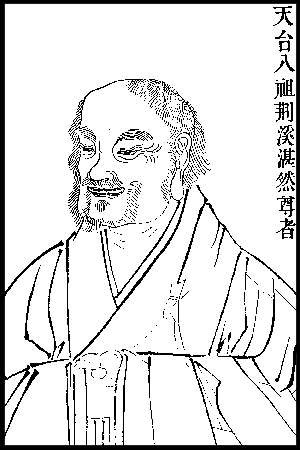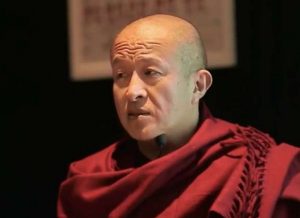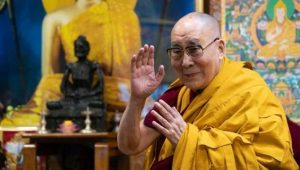
Tiantai Buddhism (天台宗) is so named because the school’s fourth patriarch, the Great Master Zhiyi (智顗大師), had his headquarters on Mount Tiantai, in Tiantai County, near the city of Taizhou on the eastern coast of China’s Zhejiang Province. The school is also known as the Lotus School because it reveres the Sūtra on the White Lotus of the Sublime Dharma—Saddharmapundarika Sutra or 妙法蓮華經—as the Buddha’s highest teaching, especially that of expedient means.
All non-Indian schools of Buddhism trace their lineages back to an Indian progenitor. Tiantai Buddhism is no exception, as Nagarjuna, the great founder of the Madhyamaka philosophical school, is conventionally considered the primogenitor of Tiantai Buddhism. The second patriarch of the school is the northern Chinese monk-scholar, Huiwen (慧文, who studied Nagarjuna’s Treatise on the Middle Way and Treatise on the Great Wisdom-Perfection extensively, in order to create a meditative practice known as the “three-fold contemplation in a single mind,” the core of Tiantai meditative practice that allows one to attain enlightenment by perceiving the unification of the three truths: emptiness, impermanence, and the Middle Way.
His successor, the meditation master Nanyue Huisi (南嶽慧思, 515–77), devoted his post-enlightenment life to propagating the Lotus Sutra all over China. Huisi’s heir and Tiantai’s fourth patriarch, Tiantai Zhiyi (天台智顗 538–97), is a crucial figure in Tiantai’s history because he created the School’s “classification of teachings” (判教) and did the most to systematize Tiantai’s philosophical doctrines and meditative practices. The next major figure in the Tiantai lineage is the ninth patriarch and subject of this article, Miaole Zhanran (妙樂湛然, 711–82).
Zhanran lived during one of the most glorious eras of Chinese culture and literature, when the populous and flourishing Tang capital city, Chang’an (長安), served as a crossroads of cultural exchange across Asia.
Zhanran, lay surname Qi (戚), was born in Jinling Jingxi (晉陵荊溪), modern day Jiangsu Yixing (蘇宜興), circa 711. He was born to a Confucian family and was deeply immersed in Confucian studies from a young age, but he wasn’t satisfied with Confucian theories and already possessed a transcendent mind even in his youth. At the age of 17 (16 by Julian reckoning), he traveled to eastern Zhejiang to continue his studies. There, he met a monk named Fangyan of Jinghua who taught him the fundamentals of the Tiantai doctrine. As a result of this encounter, Zhanran decided to abandon the pursuit of a worldly career, and instead devoted himself to the study of the Buddhist teachings.
Zhanran journeyed to the residence of Xuanlang, the eighth patriarch and the fifth successor in the line of Zhiyi’s teachings, on Mount Zuoxi to ask him directly for instruction in Tiantai teachings. Zhanran did not don clerical robes and renounce the home (a Chinese Buddhist expression for ordination) until Master Xuanlang deemed him ready to be his heir. In the meantime, Xuanlang set about teaching Zhanran all that he knew about the philosophical doctrines and meditation practices of the Tiantai school, while Zhanran was still a Confucian scholar, which was an indication of Xuanlang’s faith in Zhanran’s future.
Xuanlang (玄郎) realized Zhanran’s potential after the following exchange:
Xuanlang to Zhanran, “What have you dreamed recently?”
Zhanran replied, “For the past several nights, I dreamed I saw myself clad in monk’s robes, with two wheels beneath my armpits, when I was in the middle of the sea.”
Xuanlang, having heard this, happily replied, “This foretells your salvation of sentient beings from the sea of samsara through your meditative practices and understanding of the Dharma.”
Upon hearing this, Xuanlang set upon transmitting everything he knew to Zhanran. Zhanran was ordained at Jingle Monastery (淨樂寺), in a hamlet by Yixing (宜興), at the age of 38. His ordination was technically also his “graduation ceremony,” since Master Xuanlang had already chosen him as his heir and he had passed his qualifications.
Zhanran received imperial summons from three different emperors: Xuanzong (685–762), Suzong (711–62), and Daizong (727–79). He declined all three of the summons, citing ill health. Instead, he chose to follow Master Zhiyi’s example by residing on Mount Tiantai.
While Zhanran used ill health as an excuse to decline the imperial summonses, in reality there was nothing preventing him from traveling; during the reign of Suzong, he traveled as far as Nanyue in southern China, and during the reign of Daizong, Zhanran went on pilgrimage to Mount Wutai, in the far north. His main reason for declining the imperial invitations to journey to the capital was that he saw no advantage in doing so. Accepting the invitation might even place him in a position where he would have to compromise the principles of the Tiantai doctrine, since the three emperors, especially Xuanzong, favored incantations and other magical and semi-magical rituals of Esoteric Buddhism. To Zhanran, the Tiantai doctrine constituted the orthodox Buddhist teachings and he had no desire to see them sullied by the errors of other schools, especially that of Esoteric Buddhism.
Zhanran played an important role in transmitting the Tiantai doctrines to Japan. When the Japanese monk Saichō (最澄; later known as Dengyō 伝教) came to China in search of a deeper understanding of Tiantai, he studied under two of Zhanran’s disciples, Daosui (道邃 b. c. 804) and Xingman (行滿 b. c. 804). Through their instruction and through Zhanran’s writings, he gained a thorough understanding of Tiantai teachings and propagated them in Japan after his return. In fact, the founder of Nichiren Buddhism, Nichiren (日蓮, 1222–82), was an ordained Tendai (Jap. Tiantai) monk.
In one sense, his life may seem to have been quiet, devoted to study, writing, and the training of disciples, but Zhanran was anything but passive in his defense of what he regarded as the true principles of Buddhism. He set out to vigorously refute the errors of others, traveling widely in both northern and southern China, and up the Yangtze River to the far west, combating philosophical errors in Buddhist teachings and spreading the doctrines of the Tiantai school. As the restorer of the school’s fortunes, he was a man of action; devoting himself unsparingly to the propagation of the Buddhist doctrine.
Sources:
Endō, Asai. “The Lotus Sutra as the Core of Japanese Buddhism: Shifts in Representations of its Fundamental Principle.” Japanese Journal of Religious Studies 41/1 (2014): 45-64.
Chinese Buddhist Encyclopedia. “Threefold contemplation in a single mind.” Last modified 22 April 2014.
Ikeda, Daisaku. 2009. The Flower of Chinese Buddhism: The Soka Gakkai History of Buddhism Series. Trans. Burton Watson. Santa Monica: Middleway Press.
賴永海. 1993. 湛然: 世界哲學家叢書. 由傳偉勳及韋政通編輯. 臺北市:東大出版社.














